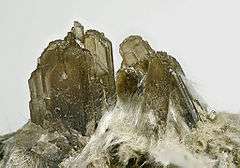Clinozoisite
| Clinozoisite | |
|---|---|
|
Clinozoisite | |
| General | |
| Category |
Sorosilicates Epidote group |
| Formula (repeating unit) | Ca2Al3(Si2O7)(SiO4)O(OH) |
| Strunz classification | 9.BG.05a |
| Dana classification | 58.2.1a.4 |
| Crystal system |
Monoclinic Prismatic class |
| Space group |
Monoclinic H-M symbol: (2/m) Space group: P21/m |
| Unit cell |
a = 8.879, b = 5.583 c = 10.155 [Å]; β = 115.50°; Z = 2 |
| Identification | |
| Color | Colorless, green, gray, light green, yellow green |
| Crystal habit | Elongated primatic crystals, striated; granular to fibrous |
| Twinning | Lamellar on {100} uncommon |
| Cleavage | Perfect on {001} |
| Fracture | Irregular/uneven |
| Tenacity | Brittle |
| Mohs scale hardness | 6-7 |
| Luster | Vitreous |
| Streak | Grayish white |
| Diaphaneity | Transparent to translucent |
| Specific gravity | 3.3 - 3.4 |
| Optical properties | Biaxial (+) |
| Refractive index | nα = 1.706 - 1.724 nβ = 1.708 - 1.729 nγ = 1.712 - 1.735 |
| Birefringence | δ = 0.006 - 0.011 |
| 2V angle | 14 to 90° measured |
| References | [1][2][3] |
Clinozoisite is a complex calcium aluminium sorosilicate mineral with formula: Ca2Al3(Si2O7)(SiO4)O(OH). It forms a continuous solid solution series with epidote by substitution of iron(III) in the aluminium (m3 site) and is also called aluminium epidote.[1]
Clinothulite is a manganese bearing variety with a pinkish hue due to substitution of Mn(III) in the aluminium site.[4]
It was originally discovered in 1896 in East Tyrol, Austria, and is so-named because of its resemblance to zoisite and its monoclinic crystal structure.[1]
It occurs in rocks which have undergone low to medium grade regional metamorphism and in contact metamorphism of high calcium sedimentary rocks. It also occurs in saussurite alteration of plagioclase.[2]
References
- Nesse, William D., "Introduction to Mineralogy," (c)2000 Oxford University Press ISBN 0-19-510691-1
This article is issued from Wikipedia - version of the 9/13/2016. The text is available under the Creative Commons Attribution/Share Alike but additional terms may apply for the media files.
